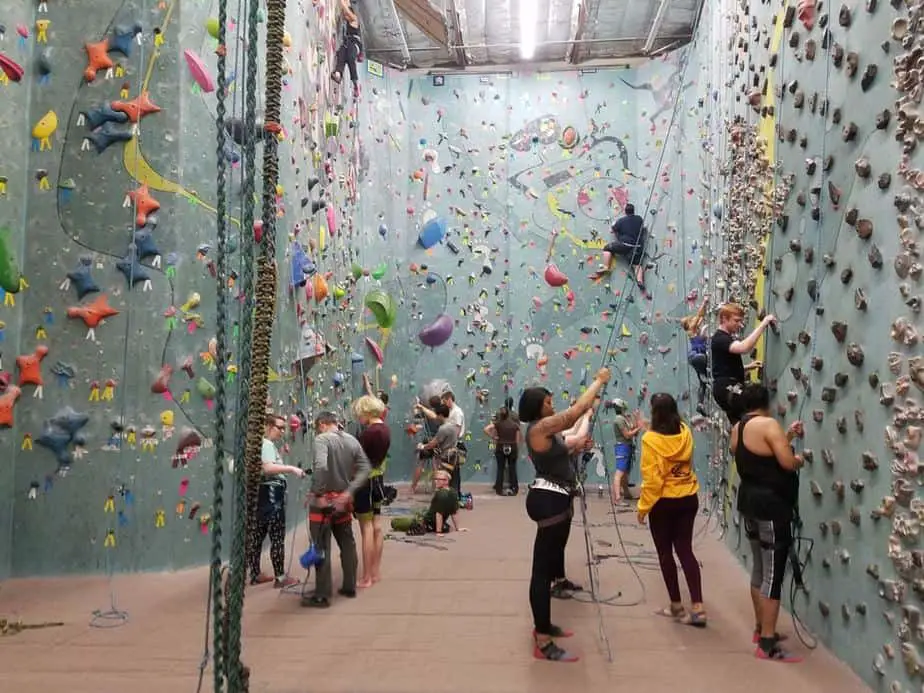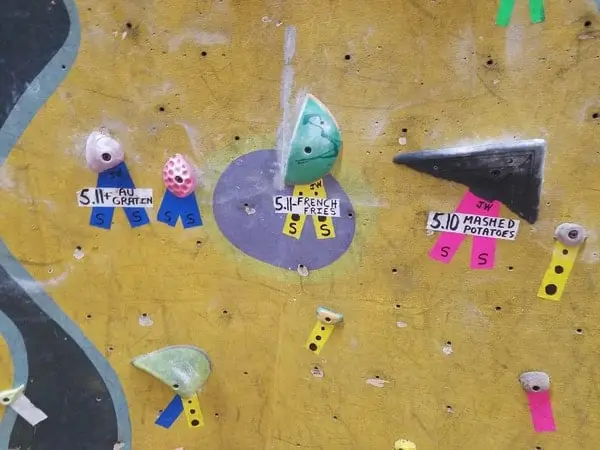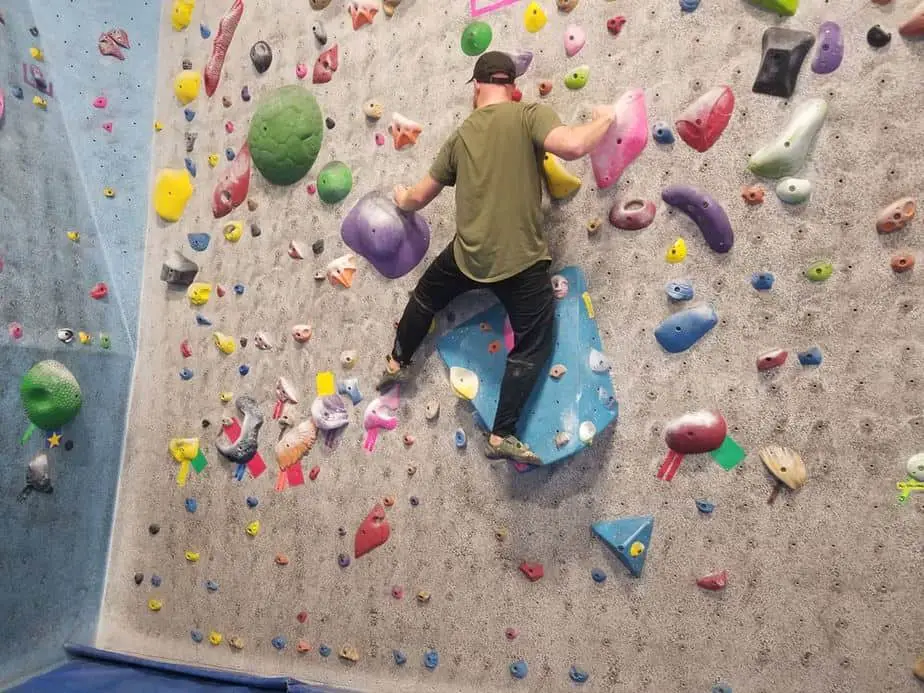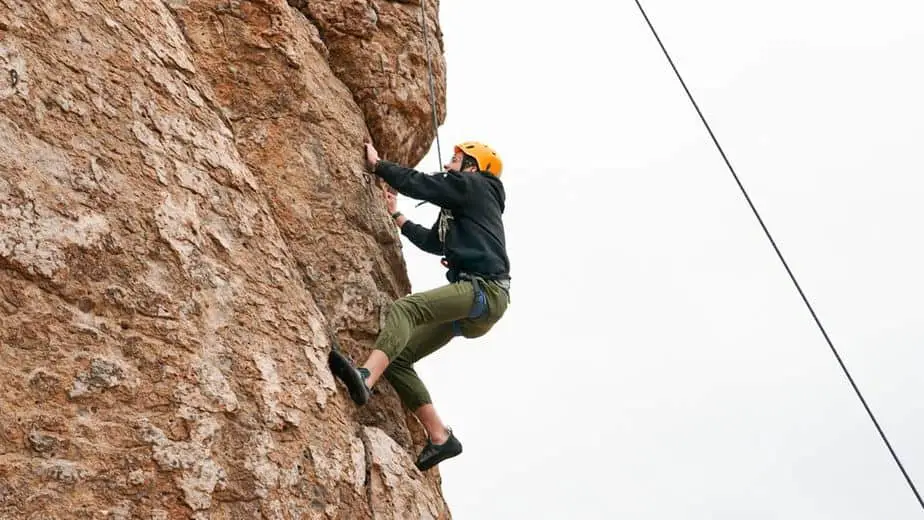In the last decade, rock climbing has become less of a fringe adventure sport, and more of a mainstream activity. While any sport can feel intimidating to a beginner, rock climbing can feel especially so because it involves leaving the safety of the ground. There is also a lot of equipment used in rock climbing that is not used in other sports, such as ropes and harnesses, that might make climbing seem even more difficult to a new climber.
Rock climbing is not hard for beginners; if you can climb a ladder, you can definitely go rock climbing. Climbing routes and bouldering problems come in different difficulty levels ranging from easy to very hard. Start with something easy in your comfort zone, and then work to improve.
Like any sport, rock climbing requires a mix of skill, strength, and practice to get better. However, unlike some sports where a certain amount of strength or athleticism is required to have fun as a beginner, rock climbing is accessible to everyone- even people who have never tried a sport before! Read on to learn why climbing can be easy for beginners, and how to get ready for your first time climbing.
Why Climbing Can Be Easy For Beginners
Rock climbing may seem like an extreme sport, and it’s true that experts use their climbing skills to access some pretty remote and dangerous places. However, there are many reasons why climbing can be easy for beginners.
There are really two aspects of climbing that are difficult for beginners- the physical challenge and the mental edge. For most beginners, the mental hurdle of climbing up high into the air and trusting a rope to support or catch them is the most difficult aspect.
People have a natural fear of heights that can make it difficult to enjoy leaving the ground. It can help to shift your mindset and think of it like swings at a park or even a roller coaster. Enjoy the adrenaline, and let your mind conquer the innate fear.

Start Climbing In Climbing Gyms
Climbing gyms are popping up everywhere in the world, even in small towns or in places that aren’t close to any mountains, thus providing an incredible amount of accessibility to an otherwise extreme sport.
It’s a great idea for a beginner climber to make their first venture into climbing at a gym. There are several reasons for this:
- Safety: Climbing gyms pay trained staff to make sure you are safe when you start climbing. Many gyms also offer classes for beginners to teach the basics!
- Controlled Environment: You don’t have to worry about the weather or other conditions when you head to the gym, other than after-work crowds. This leaves you completely free to focus on doing your best and having fun. Additionally, the ground is covered in a big thick foam pad instead of dirt and sharp rocks!
- Grade Ranges: Gyms do a great job of catering to both beginner and advanced climbers, so as a new climber you should have no trouble finding climbs to try that will feel within your abilities, even on your first day!
- Gear Rentals: Most gyms let you rent all the gear you need for rope climbing or bouldering, so beginners don’t have to make a big initial investment in the sport when they are just trying it out.
Guiding Services
If you want your first climbing experience to be outdoors, guiding services can make your first time really easy! While more expensive then going to a gym, guiding services can handle all the logistics of your first time climbing.
Guides can provide a similar experience to a gym in terms of safety, grade ranges, and gear, but in the more exciting environment of an outdoor location. Plus nothing feels better than getting to the top of an outdoor climb and taking in the view!
How Do I Make My First Time Climbing Easy?
The hardest part about being a beginner at anything is trying that new skill for the very first time. Don’t be intimidated to start climbing! Here are several ways to make sure your first time climbing is easy and fun.

Learn about climbing grades
Climbing routes, both outdoors and in the gym, use grading systems to let the climber know how difficult the route is. At most gyms, these grades will be clearly marked at the start of each route. Here is a quick overview of the grading systems used in the United States:
- V-Scale: This grading system is used for bouldering, and consists of grades from V0 – V17.
- The lower the number that comes over the “V”, the easier the route
- Example: V1 is easier than V2
- Some gyms also use the grade VB or V“Beginner” to designate routes to try on your first day climbing
- Your first few times you’ll want to stick with V0 and V1.
- The lower the number that comes over the “V”, the easier the route
- YDS: This grading system is used for roped climbing, and consists of grades from 5.0 – 5.15d.
- The first number, “5”, means “5th class” and it designates the steepness of the route itself. This number will never change!
- The numbers after the decimal point designate the difficulty of that 5th class route. The lower the number after the decimal, the easier the route.
- Example: 5.9 is easier than 5.10
- Some grades end with a letter from “a” – “d”, which help further define the difficulty of a route.
- Example: 5.10d is harder than 5.10c, because d is after c in the alphabet
- Example: 5.11a is harder than 5.10d, because 11 is a higher number than 10
- Gyms usually start at the 5.5-5.6 range. This is the difficulty that anyone who can climb a ladder can do. The hand and footholds are big and shaped so they are easy to grab. They are plentiful on the route so you don’t have to hopelessly contort yourself in order to grab them.

Bring a Buddy
It’s always nice to have a friend when you’re trying something new! If you already have a regular workout buddy, see if they would like to try a new sport. This will help you feel more comfortable working out and trying hard in an otherwise new environment.
If you don’t have a friend interested in trying climbing with you, search online for climbing meetups or other social groups in your area for beginners. Many people find lifelong climbing partners this way, and as a beginner it’s great to connect with others in your same position!
Stretch Beforehand
Even if most gyms provide climbs that are accessible and often easy for beginners, it’s important to get your body ready for a new form of exercise. Climbing something as easy as a ladder over and over again can make you sore if it’s your first time!
Climbing is a full body workout, but your upper body muscles will probably get the biggest workout when you first start climbing. Make sure to stretch your shoulders, triceps, biceps, and forearms before climbing, and regularly between climbs and after your session.
Some climbers also like to do a light warmup before climbing, such as a short jog on a treadmill or jumping jacks. The more you prepare your body for your first time climbing, the easier it will feel!
Mentally Prepare
Often, the hardest part about climbing for beginners is not the physical aspect, but the mental one. Different forms of climbing present different mental barriers, and knowing what to expect can make dealing with these challenges much easier.
Learn to trust the equipment. A climbing rope is strong enough to lift you and ten of your closest friends. The harness and carabiners aren’t going anywhere. The equipment is rock-solid (sorry)! Learn to trust it by hanging from the rope a few feet off the ground and taking short practice falls.
When you are toprope climbing, you can get anywhere from 30-60 feet (10-20m) off the ground! If you are afraid of heights, progress up the wall slowly, and come back down if you start feeling too scared. Once you’re more used to climbing and how all the equipment works, you will slowly start feeling more comfortable going higher!
When you are bouldering, you don’t get very high off the ground, but if you fall you don’t have a rope to catch you. To get over a fear of falling, practice jumping off the bouldering wall and landing properly while close to the ground.
When you are comfortable with the mechanics of proper falling and landing technique, you will feel more comfortable bouldering all the way up the wall.
Have a Good Attitude!
The Best Climber is the One Having the Most Fun
Climber Alex Lowe
This is a great motto for climbers, especially when you’re a beginner. Climbing can be enjoyable whether you are climbing something easy or difficult, so even if climbing feels more difficult at first than you were expecting, having a good attitude, doing your best, and having fun are the most important things you can do.

Related Questions
What’s the Easiest Form of Climbing? Bouldering is the easiest form of climbing to get into because it requires the least amount of equipment- just shoes, chalk, and a crashpad. At the gym, there will already be padding under the bouldering routes, and you can rent shoes and chalk.
However, beginner bouldering grades are equivalent to more moderate rope-climbing grades, so many beginner climbers feel like bouldering is difficult at first.
Toprope climbing requires more gear, most notably a rope and a harness. At a gym, ropes will already be set up, and you can rent a harness. Additionally, you will need to learn how to belay for toprope climbing; most gyms provide belay classes to beginners.
Once you have the gear and the belay skills, toprope climbing provides more routes at easier grades than bouldering! Look for routes between 5.0 – 5.6 to get started.
How Do I Make More Difficult Grades Feel Easier? To get better at climbing, focus on footwork; this will give the muscles in your arms a break while helping you improve your technique. Climbing is both a strength and skill sport, so even experienced climbers who don’t look very physically strong can climb really hard because they have excellent technique. The best way to get better at climbing is to just keep at it!


